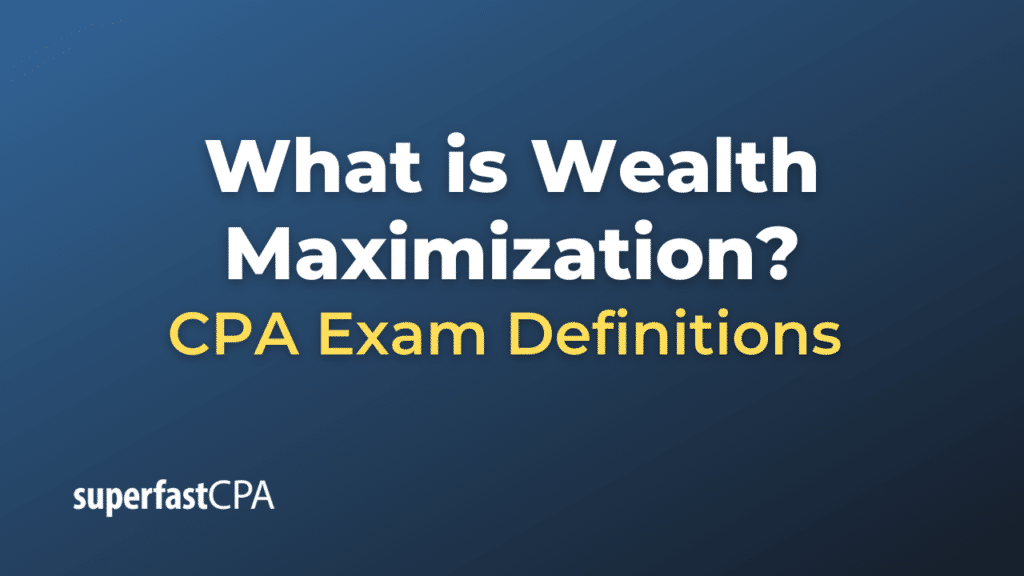Wealth Maximization
Wealth maximization is an investment or financial management goal that seeks to grow the monetary value of an asset or portfolio over time. This objective serves as a guiding principle for many types of financial decisions, including those made by individual investors, financial managers, and executives of corporations. In a corporate context, the wealth maximization goal posits that the primary objective of a business should be to increase the value of its stock or the total market value of its equity capital.
Key Points:
- Shareholder Value: In a business context, wealth maximization aims to maximize shareholder value, often reflected in a rising stock price or increased dividends. This focus assumes that management’s primary responsibility is to make decisions that enhance shareholder wealth.
- Long-term Focus: Wealth maximization is generally a long-term objective, in contrast to profit maximization, which may target short-term earnings. It accounts for the time value of money, considering the present value of cash flows that an investment will generate in the future.
- Risk-Return Trade-off: The goal of wealth maximization also takes into account the risk associated with different financial decisions. Investment options that offer higher expected returns often come with higher risk, and wealth maximization aims for an optimal risk-return balance.
- Comprehensive: Wealth maximization considers multiple factors including earnings per share, dividend payments, and the growth rate of these financial metrics, unlike profit maximization, which focuses narrowly on profits.
- Ethical and Social Responsibility: Although the primary focus is on increasing wealth, this goal is often balanced with ethical considerations and social responsibilities. Many modern companies adopt a broader stakeholder approach, considering not just shareholders but also employees, customers, and the community at large.
- Applicability: This principle can apply to individuals as well, where the goal would be to maximize personal wealth by making sound financial decisions related to savings, investments, and expenditures.
Example of Wealth Maximization
Let’s explore a fictional example involving two investment choices to illustrate the concept of wealth maximization.
Imagine you are an individual investor named Alex. You have $10,000 to invest and two primary options to consider:
- Invest in a High-Yield Savings Account: The bank offers a 2% annual interest rate on a high-yield savings account. It’s low-risk but also provides a relatively low return.
- Invest in the Stock Market: You could also invest in a diversified stock portfolio. This option is riskier but has a historical average return of around 7% per year.
Wealth Maximization Analysis:
- High-Yield Savings Account: If you choose the savings account, your $10,000 would grow to $10,200 at the end of one year, assuming an interest rate of 2%. In 5 years, compounded annually, it would be approximately $11,040.60.
- Formula: FV = P(1 + r)t
- FV = 10,000(1 + 0.02)5
- FV = 11,040.60
- Stock Market: If you invest in the stock market, with an average return of 7%, your $10,000 could grow to $10,700 after one year. In 5 years, it could be approximately $14,025.43, assuming the returns are compounded annually.
- Formula: FV = P(1 + r)t
- FV = 10,000(1 + 0.07)5
- FV = 14,025.43
Decision:
- Risk vs. Reward: The stock market is riskier but offers a higher potential return, whereas the savings account is safer but has limited growth potential.
- Time Value of Money: The longer-term growth potential of the stock market investment, if it performs as historically expected, is higher than the savings account.
- Wealth Maximization Objective: If Alex’s goal is to maximize wealth, the stock market investment aligns more closely with this objective, despite the higher risk.
By choosing to invest in the stock market, Alex is adhering to the principle of wealth maximization. He is choosing an investment that has the potential for higher returns over time, albeit at a higher risk. Note that this is a simplified example and doesn’t take into account factors like taxes, transaction costs, or the potential for diversification to mitigate risk. Nonetheless, it serves to illustrate the fundamental idea behind wealth maximization: choosing the option that is expected to yield the most significant growth in value over time, adjusted for risk.













